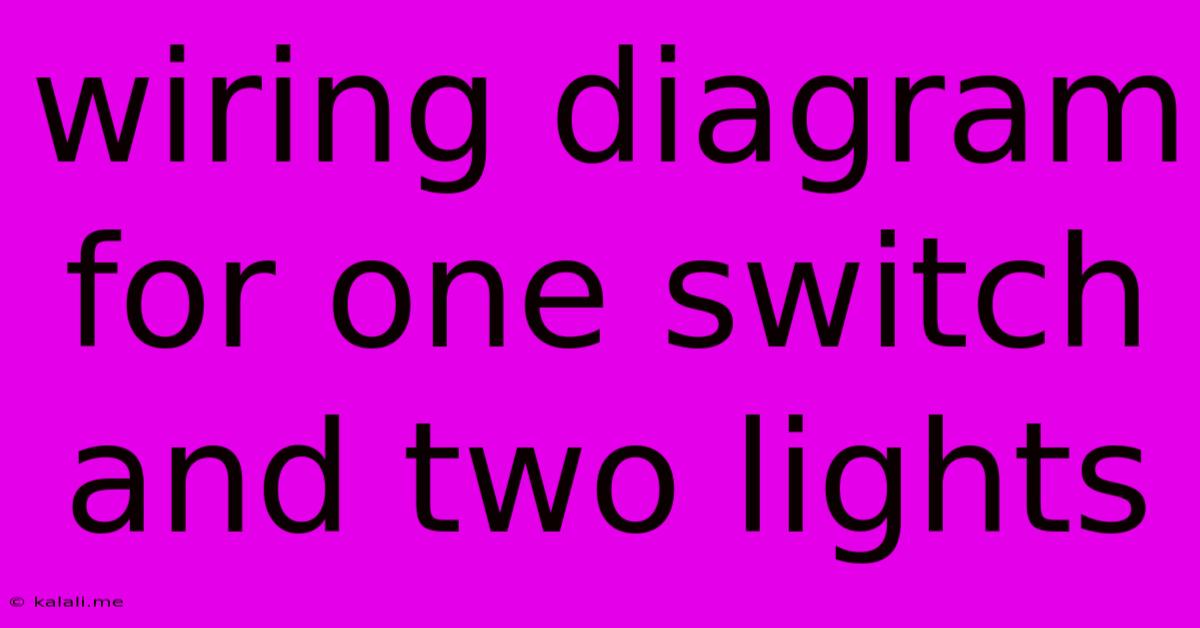Wiring Diagram For One Switch And Two Lights
Kalali
Jun 02, 2025 · 4 min read

Table of Contents
Wiring Diagram for One Switch and Two Lights: A Simple Guide
This article provides a comprehensive guide to understanding and implementing a wiring diagram for a single switch controlling two lights. This common household wiring setup is surprisingly straightforward, but understanding the basic principles of electricity and following safety precautions is crucial. We'll cover the necessary materials, step-by-step instructions, and troubleshooting tips, ensuring you can confidently tackle this project.
What you'll need:
- Two light fixtures: Ensure each fixture is rated for the appropriate voltage and wattage of your electrical system.
- One single-pole switch: This type of switch is designed to control a circuit from a single location.
- Electrical wire: Use appropriately sized and rated wire for your circuit's amperage. Commonly used are 14-gauge or 12-gauge wires. Always use wire that's rated for the intended voltage of your electrical system.
- Junction box: This will house the wire connections and protect them from damage.
- Wire connectors (wire nuts): Ensure they are appropriately sized for the number of wires you are connecting.
- Voltage tester: Essential for verifying the power is off and for testing the circuit after installation. Never skip this step.
- Screwdrivers: Phillips and flathead screwdrivers are usually necessary.
- Pliers: Helpful for stripping wire insulation.
Understanding the Circuit:
The core concept behind this wiring is a simple parallel circuit. Both lights are connected in parallel to the switch, meaning each light receives the full voltage from the power source, independently of the other. This means one light can fail without affecting the other.
The switch acts as an on/off control for the entire circuit. When the switch is closed (turned on), the current flows through the circuit, lighting both lights. When the switch is open (turned off), the current flow is interrupted, and both lights turn off.
Step-by-Step Wiring Instructions:
1. Safety First: Always turn off the power at the breaker box before beginning any electrical work. Double-check with a voltage tester to ensure the power is off at the switch and light fixture locations.
2. Wire the Light Fixtures: Connect the wires at each light fixture according to the fixture's instructions. Typically, this involves connecting the black (hot) wire to the black wire from the circuit, the white (neutral) wire to the white wire from the circuit, and the bare copper (ground) wire to the ground wire from the circuit.
3. Wire the Junction Box: This box acts as a central connection point. Carefully connect the wires from the power source, the switch, and the two light fixtures within the junction box. Accurate wire connections are crucial. The specifics will depend on your existing wiring setup, but a typical configuration is as follows:
- Power Source: Black wire to one of the black wires coming from the switch. White wire to one of the white wires coming from the switch. Ground wires are connected together.
- Switch: The incoming black wire is connected to the common terminal on the switch. The remaining two black wires from the lights are connected to the two switch terminals. White wires from both light fixtures and the power source are connected together.
- Light Fixtures: The black wires from the switch are connected to each of the light fixtures separately, as are the white neutral wires.
4. Secure the Connections: Carefully twist each wire connection and securely cap them with wire connectors (wire nuts).
5. Mount the Switch and Light Fixtures: Mount the switch and light fixtures in their designated locations.
6. Restore Power: Turn the power back on at the breaker box.
7. Test the Circuit: Use the voltage tester to double check that there's power to the lights and switch before testing the switch to make sure the lights are working correctly.
Troubleshooting Tips:
- Lights don't work: Check all wire connections, the breaker box, and the switch itself.
- Only one light works: Check the connections at the light fixture that's not working. Inspect each connection for proper wire twists and securely tightened wire nuts.
- Flickering lights: This could indicate a loose connection or a problem with the wiring.
Remember, if you are uncomfortable working with electricity, it is always best to consult a qualified electrician. This guide is intended for informational purposes only and should not be considered a substitute for professional electrical work. Incorrect wiring can lead to electrical hazards. Always prioritize safety!
Latest Posts
Latest Posts
-
Backward Bending Supply Curve For Labour
Jun 04, 2025
-
How Do I Block An Outgoing Phone Call
Jun 04, 2025
-
Best Place To Buy Ammo Fallout 4
Jun 04, 2025
-
Pdp Afterglow Switch Controller Reset Pc
Jun 04, 2025
-
Google Drive Has Multiple Copies Of Same File
Jun 04, 2025
Related Post
Thank you for visiting our website which covers about Wiring Diagram For One Switch And Two Lights . We hope the information provided has been useful to you. Feel free to contact us if you have any questions or need further assistance. See you next time and don't miss to bookmark.